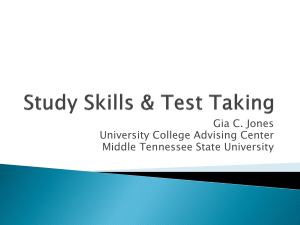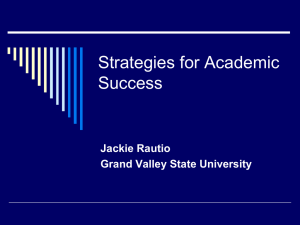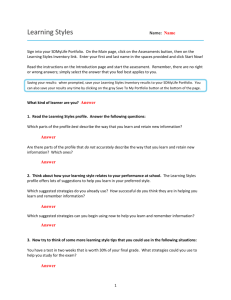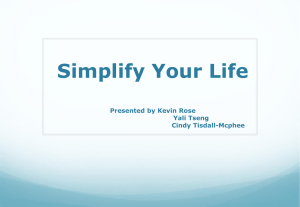Learning Styles Study Strategies - University Center for Academic
advertisement
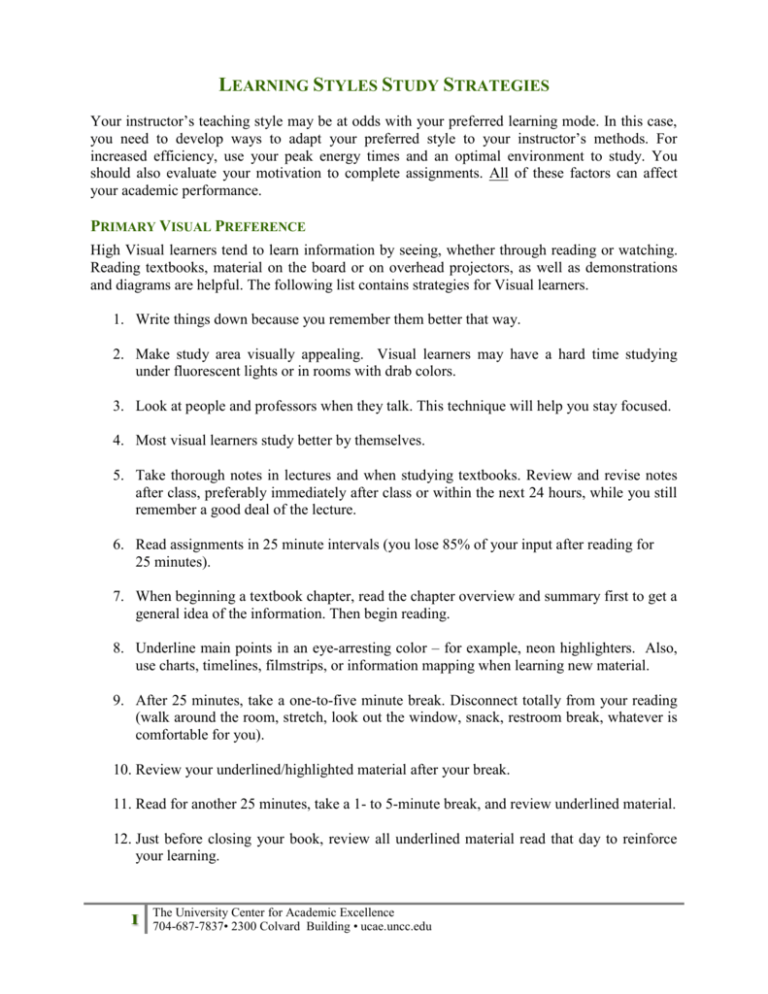
LEARNING STYLES STUDY STRATEGIES Your instructor’s teaching style may be at odds with your preferred learning mode. In this case, you need to develop ways to adapt your preferred style to your instructor’s methods. For increased efficiency, use your peak energy times and an optimal environment to study. You should also evaluate your motivation to complete assignments. All of these factors can affect your academic performance. PRIMARY VISUAL PREFERENCE High Visual learners tend to learn information by seeing, whether through reading or watching. Reading textbooks, material on the board or on overhead projectors, as well as demonstrations and diagrams are helpful. The following list contains strategies for Visual learners. 1. Write things down because you remember them better that way. 2. Make study area visually appealing. Visual learners may have a hard time studying under fluorescent lights or in rooms with drab colors. 3. Look at people and professors when they talk. This technique will help you stay focused. 4. Most visual learners study better by themselves. 5. Take thorough notes in lectures and when studying textbooks. Review and revise notes after class, preferably immediately after class or within the next 24 hours, while you still remember a good deal of the lecture. 6. Read assignments in 25 minute intervals (you lose 85% of your input after reading for 25 minutes). 7. When beginning a textbook chapter, read the chapter overview and summary first to get a general idea of the information. Then begin reading. 8. Underline main points in an eye-arresting color – for example, neon highlighters. Also, use charts, timelines, filmstrips, or information mapping when learning new material. 9. After 25 minutes, take a one-to-five minute break. Disconnect totally from your reading (walk around the room, stretch, look out the window, snack, restroom break, whatever is comfortable for you). 10. Review your underlined/highlighted material after your break. 11. Read for another 25 minutes, take a 1- to 5-minute break, and review underlined material. 12. Just before closing your book, review all underlined material read that day to reinforce your learning. 1 The University Center for Academic Excellence 704-687-7837• 2300 Colvard Building • ucae.uncc.edu 13. Write new vocabulary words on colored index cards (or write in color on white index cards) with short definitions on the back. Carry these with you and reviewed them at odd moments or whenever you have spare time – for example, before class or when waiting in line. PRIMARY AUDITORY PREFERENCE High Auditory learners benefit from listening – hearing the information and processing it accordingly. Auditory learners focus easily on sounds and have good memory of what they have heard through lectures or on tape. The following hints are useful for Auditory learners. 1. Try studying with a friend so that you can talk out loud and hear the information. 2. Recite out loud the things you want to remember, and make mind pictures as you recite information 3. Tape your lectures and review your notes while listening to your tape. This gives a double auditory input. Transfer your notes to index cards that you can carry with you and review aloud. 4. Read an assignment for 25 minutes (no more – you lose 85% of your input after the first 25 minutes.) When beginning a textbook chapter, read the summary to get a general idea of the information. Then begin the reading. (You might even try reading aloud). 5. Underline main points in an eye-arresting color – for example, neon highlighters. 6. At the end of 25 minutes, take a one-to-five minute break. Disconnect totally from your reading – exercise, relax, snack – whatever is comfortable for you. 7. Review aloud all underlined materials. If you take notes in addition to underlining in the book, read your notes aloud as well. 8. Read for 25 minutes and underline. 9. Take a break. 10. Review aloud from beginning of underlined material. Repeat. PRIMARY TACTILE PREFERENCE High Tactile learners acquire knowledge best through manipulation – doing, touching, hands-on, and writing techniques. Primary Tactile learners would benefit from finding their secondary learning mode and use the directions for either Visual or Auditory in conjunction with the following hints. 1. Write things down because you remember them better that way. 2. Try studying with a friend so that you can talk out loud and hear the information. 2 The University Center for Academic Excellence 704-687-7837• 2300 Colvard Building • ucae.uncc.edu 3. When memorizing, pace or walk around while reciting to yourself or looking at a note card, and also try writing the information on a desk with your fingers. Exercise while studying, such as on a treadmill. 4. Keep something in your hand that is malleable. Knead or tap to a rhythm as you study. As much as you can, translate what you are learning into something that can be touched. Typing is helpful, as is writing your notes. If possible, type your notes on index cards. Eating, drinking, chewing gum, and listening to music are also helpful. 5. Read an assignment for 25 minutes (no more – you lose 85% of your input after the first 25 minutes.) When beginning a textbook chapter, read the summary to get a general idea of the information. Then begin the reading. 6. Underline main points in an eye-arresting color – for example, neon highlighters. Tactile learners should type or rewrite their notes whenever possible. 7. At the end of 25 minutes, take a one-to-five minute break. Disconnect totally from your reading – exercise, relax, snack – whatever is comfortable for you. 8. Review underlined material after your break. If Auditory is your secondary preference, review aloud all underlined materials. 9. Read for 25 minutes and underline. 10. Take a break. 11. Review from the beginning of underlined material. 12. To learn a sequence-write it down on flashcards and practice arranging in order. 13. Make learning tangible by draw pictures or charts while taking notes 3 The University Center for Academic Excellence 704-687-7837• 2300 Colvard Building • ucae.uncc.edu


